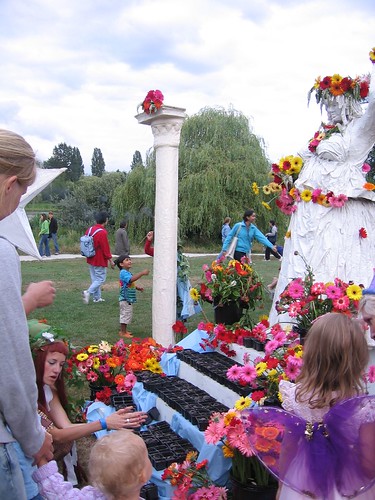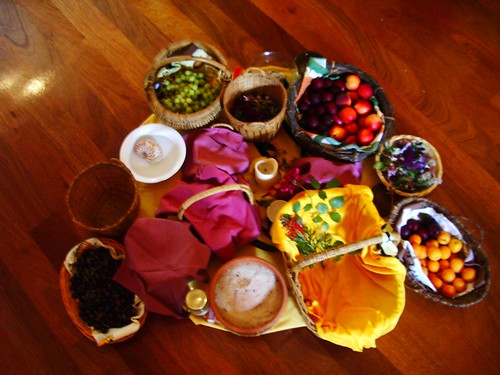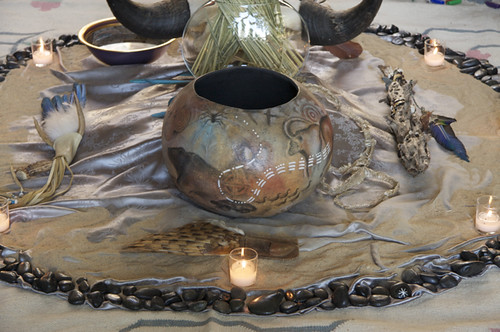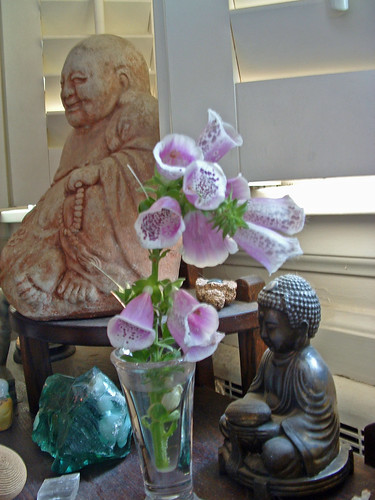Now summer is in flower and natures hum
Is never silent round her sultry bloom
Insects as small as dust are never done
Wi' glittering dance and reeling in the sun
And green wood fly and blossom haunting bee
Are never weary of their melody
Round field hedge now flowers in full glory twine
Large bindweed bells wild hop and streakd woodbine
That lift athirst their slender throated flowers
Agape for dew falls and for honey showers
These round each bush in sweet disorder run
And spread their wild hues to the sultry sun
~June by John Clare {read the rest here}.
For those of us in the Northern Hemisphere, it will be the Summer Solstice (or Midsummer as it is often called) on June 21st, which of course is the longest day of the year.
By now even for those of us more North than most, there is green and blossom everywhere, the birds are singing their tunes at all hours, and gardening season is well underway.
After the Winter we had (snow at the end of May!), I definitely feel like celebrating the coming of Summer!
I hope to spend the day wildcrafting some plants for my dwindling supply...the Tansy, Devil's Paintbrush, and St. John's Wort is ready! I will also do my rounds of leaving offerings in a couple of my secret spots, and one for our somewhat newly appointed garden project space (more about that in another post).
There are various celebrations and observences around this time such as St. John's Day, Litha, Ivan Kupala, and Golowan. And one need only look to Carrowkeel in Ireland or Stonehenge and England to see that the importance of Midsummer goes back a long way in history.
For Wiccans and other neo-Pagans this days is known as Litha, which was the Anglo-Saxon name given to the months of June/July is Bede's De temporum ratione.
The Summer Solstice has been celebrated for eons, harking back to pre-Christian times in Northern Europe, and many later were adopted by those of the Christian faith and placed in their festival calendar.

Folks waiting for a Midsummer sunrise at Stonehenge, photo from Andrew Dunn
In places like Isle of Man, the celebration and customs of the Summer Solstice was most likely imported by the Northern Europeans. This is certainly the theory A.W. Moore had in The Folk-Lore of the Isle of Man, and goes on to claim that the origins of the festival was in honour of the sun God Baldur.
As with other festivals, fire seems to play an important role in the rites of Midsummer. A reason for this is illustrated in The Worship of the Generative Powers by Thomas Wright:
The eve of St. John was in popular superstition one of the most important days of the mediæval year. The need-fire--or the St. John's fire, as it was called--was kindled just at midnight, the moment when the solstice was supposed to take place, and the young people of both sexes danced round it, and, above all things, leaped over it, or rushed through it, which was looked upon not only as a purification, but as a protection against evil influences.
In The Golden Bough, Sir James George Frazer credits the Solstice fires to the pre-Christian ancients. He suggested that when humans learnt about the seasonal cycles, they knew that once the Midsummer sun hit noontide the sunlight would be on course to recede again, so the fires were lit to "help the sun in his seeming decline".
There is also quite a bit of mention of offerings and individuals being thrown onto the pyre as well. Apparently there were sometimes sacrifices for fertility, such as a horses to the God Freyr (The Religion of the Ancient Celts by J. A. MacCulloch).
In my opinion one of the most nifty celebrations is the Cornish Golowan Festival. A more modern spin of it comes out of Penzance, where the colourful Penglaz the 'Obby 'Oss comes out to play. Check out the video below to see some of the festivities:
Not surprisingly, there are many plants that are associated with this time of year, but maybe none more so than St. John's Wort.
According to Vivian Rich in Cursing the Basil and other Folklore of the Garden (this book is turning out to be a gem!) on St John's Day morning English girls would pick St John's Wort and place it under their pillows, and if it was not wilted they would be married within the next year. She also mentions that it was considered a sacred plant in Germany because it was thought that the strong smell would keep any malignant spirits at bay.
In Popular Romances of the West of England by Robert Hunt, there is a quoted practice of women sewing hemp seeds to divine a future husband:
At eve last midsummer no sleep I sought,
But to the field a bag of hemp-seed brought;
I scatter'd round the seed on every side,
And three times in a trembling accent cried,--
'This hemp-seed with my virgin hand I sow,
Who shall my true love be, the crop shall mow.'
I straight look'd back, and, if my eyes speak truth,
With his keen scythe behind me came the youth
Other plants I have heard of that helps to divine a future spouse around Midsummer are Roses, Daisies, Dandelions, and Pansies.
If one is looking for a fitting love charm, pick St. John's Wort, Ox-Eye Daisies, Forget-Me-Nots, and Ivy on Midsummer morning and bind the stems with red ribbon. I heard if you hang it over your bed for a whole moon, your bed would be shared soon after.
A rhyme that my Grandmother used to say to me when I was a child was:
If a Faery it is you wish to see, in new summer stand 'neath the Elder tree.
I am not sure of the origins of the rhyme, nor have I yet taken her advice, but perhaps I will one day! What I can say is that the Faeries are definitely out and about this time of year, and that was the sentiment of William Butler Yeats in Fairy and Folk Tales of the Irish Peasantry, where he stated that on Midsummer Eve the Faeries are "at their gayest".
I think Shakespeare would have agreed. ;)

For a Summer altar perhaps the most sensible adornments are leaves and blooms. I like making little bouquets or if one was more ambitious, you could try a wreath. Some other plants that are associated with this time of year are ferns, strawberries, peonies, vervain, lavender, honeysuckle, larkspur, chamomile, foxgloves, and mistletoe.
If you are looking for inspiration, here are some photos of other people's Summer altars:

Photo from meaduva

Photo from malpagaia

Photo from pipiwildhead

Photo from roniweb

Photo from Cosmic Void

Photo from sbpoet
Midsummer is an excellent time to sample local and fresh food. Here are a few recipes that you might want to try:
Baby Spinach and Raspberry Salad
Sláinte!
Laurel


Thank you for sharing all your wisdom =^) I love this article!
ReplyDeleteThanks for the ideas...I use mint flowers for sex and love talismans. Blessed litha to you all!
ReplyDeleteThank you both! :) And Hertha, thanks for the idea, I will keep that in mind!
ReplyDelete